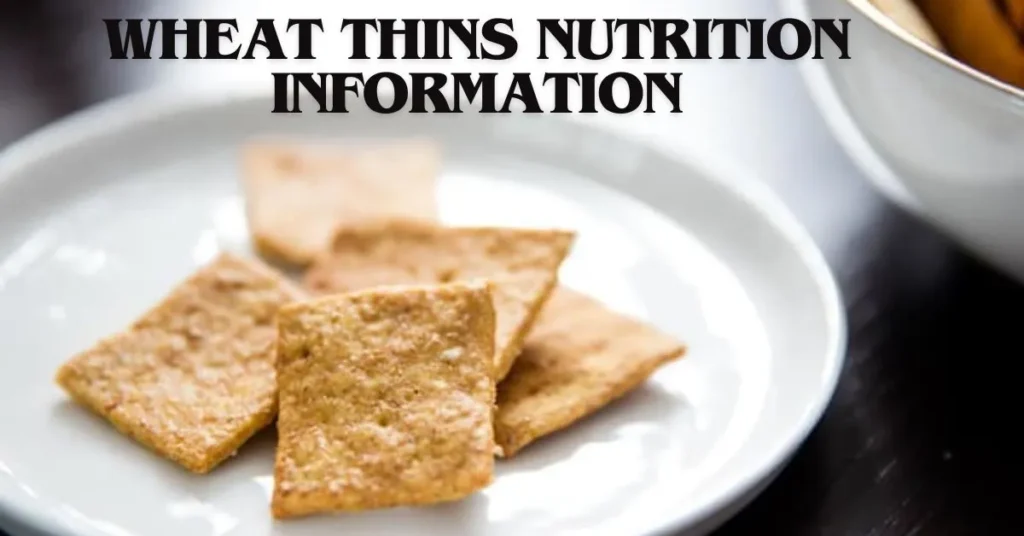Wheat Thins have been a favorite snack for many households for decades. They’re crunchy, delicious, and versatile. But have you ever stopped to think about what you’re actually eating when you reach for a box of Wheat Thins? Understanding Wheat Thins nutrition information can help you make better choices for your health. Let’s dive into the details and uncover what makes these snacks tick.
What Are Wheat Thins?
Wheat Thins are a type of baked snack cracker made by Nabisco. They’re known for their distinctive square shape, light texture, and whole wheat flavor. People often enjoy them on their own, with cheese, or as part of a snack platter. But beyond their taste and convenience, it’s essential to look at the nutritional profile to see how they fit into a balanced diet.
These crackers are marketed as a healthier alternative to traditional snacks like chips, but how do they really stack up? By examining the Wheat Thins nutrition information, we can get a clearer picture of their health benefits and potential downsides.
Basic Nutritional Breakdown:
Let’s start with the basics. According to the packaging, a standard serving size of Wheat Thins is about 16 crackers, which is roughly 31 grams. Here’s a typical nutritional profile for this serving size:
- Calories: 140
- Total Fat: 5 grams
- Saturated Fat: 0.5 grams
- Trans Fat: 0 grams
- Cholesterol: 0 milligrams
- Sodium: 200 milligrams
- Total Carbohydrates: 22 grams
- Dietary Fiber: 3 grams
- Sugars: 5 grams
- Protein: 2 grams
This basic snapshot provides a starting point for understanding the Wheat Thins nutrition information. It highlights key elements like calorie count, fat content, and carbohydrate levels, which are critical for anyone monitoring their intake.
The Good: Whole Grains and Fiber
One of the standout features of Wheat Thins is their use of whole grains. Whole grains are an important part of a healthy diet because they contain more nutrients and fiber compared to refined grains. Fiber is essential for digestive health, and it helps you feel fuller longer, which can be beneficial for weight management.
Each serving of Wheat Thins provides about 3 grams of dietary fiber, which is a decent amount for a snack. This fiber comes from whole grain wheat flour, which is the primary ingredient in these crackers. Including whole grains in your diet can help reduce the risk of heart disease, type 2 diabetes, and certain cancers.
The Not-So-Good: Sugar and Sodium:
While Wheat Thins have some positive attributes, it’s also important to look at areas where they might fall short. One concern is the sugar content. With 5 grams of sugar per serving, Wheat Thins contain more sugar than you might expect from a savory snack. This added sugar can contribute to overall calorie intake without providing significant nutritional benefits.
Sodium is another area to watch. Each serving of Wheat Thins contains 200 milligrams of sodium. While this isn’t excessively high, it can add up, especially if you’re consuming multiple servings or pairing them with other salty foods. High sodium intake is linked to increased blood pressure and a higher risk of heart disease.
Comparing Varieties:
Wheat Thins come in several varieties, each with slightly different nutritional profiles. Let’s compare a few popular options to see how they stack up.
- Original Wheat Thins: As detailed above.
- Reduced Fat Wheat Thins: These have about 120 calories, 3 grams of fat, and 2 grams of fiber per serving.
- Wheat Thins Hint of Salt: These offer a lower sodium option with 55 milligrams of sodium per serving, along with 140 calories and 3 grams of fiber.
By comparing the Wheat Thins nutrition information across different varieties, you can choose the option that best fits your dietary needs and preferences. Reduced fat and lower sodium options can be better choices for those looking to limit fat and salt intake.
Incorporating Wheat Thins into a Balanced Diet:
So, how can you enjoy Wheat Thins as part of a balanced diet? The key is moderation and pairing them with nutrient-dense foods. Here are a few tips:
- Pair with Protein: Enjoy Wheat Thins with a serving of cheese, hummus, or nut butter to add protein and healthy fats, making your snack more satisfying.
- Add Vegetables: Use Wheat Thins as a base for veggie-loaded snacks. Top them with slices of cucumber, bell peppers, or cherry tomatoes for added vitamins and minerals.
- Watch Portions: Stick to the recommended serving size to keep calorie and sodium intake in check. It’s easy to overeat snacks, especially when they’re tasty.
By being mindful of how you incorporate Wheat Thins into your diet, you can enjoy them without compromising your health goals.
Making Healthier Choices:
If you’re looking for healthier snack alternatives, there are plenty of options that provide similar crunch and flavor with better nutritional profiles. Here are a few ideas:
- Whole Grain Crackers: Look for crackers made with 100% whole grains and minimal added sugars.
- Veggie Chips: Made from real vegetables, these can offer more vitamins and fiber.
- Homemade Snacks: Consider making your own snacks at home, like baked kale chips or roasted chickpeas, to control ingredients and nutrition.
Exploring these alternatives can help you diversify your snack options and find choices that better align with your health objectives.
The Verdict: Are Wheat Thins Healthy?
So, are Wheat Thins a healthy snack? The answer depends on your dietary needs and how you consume them. They do have some nutritional benefits, such as whole grains and fiber, but they also contain added sugars and sodium.
For those who enjoy Wheat Thins, the best approach is to consume them in moderation and pair them with other healthy foods. By being mindful of portions and balancing them with nutrient-dense toppings or sides, you can make Wheat Thins a part of a healthy diet.
Conclusion:
Understanding Wheat Thins nutrition information can help you make informed choices about your snacks. These popular crackers offer a mix of benefits and drawbacks, with whole grains and fiber on the plus side and added sugars and sodium on the minus side. By incorporating Wheat Thins into a balanced diet and exploring healthier alternatives, you can enjoy their crunch without compromising your nutritional goals. Remember, the key to a healthy diet is variety, balance, and mindfulness in your food choices. Happy snacking!







